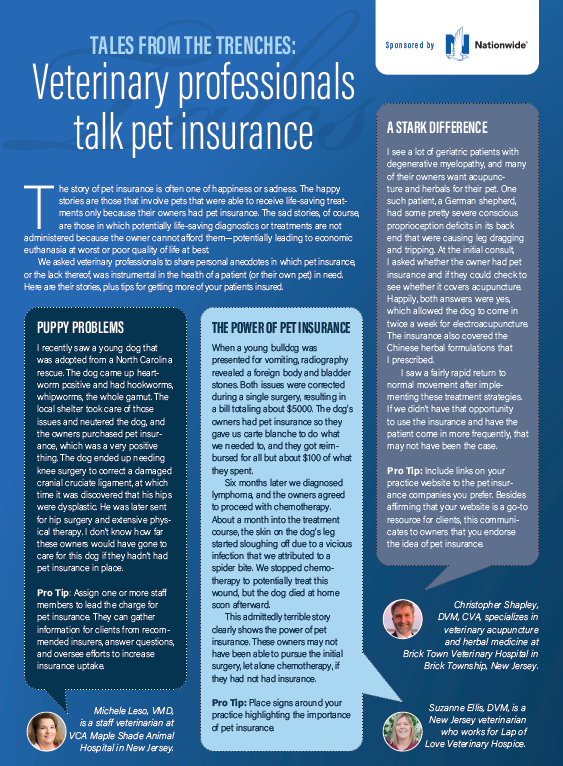Tales from the trenches: Veterinary professionals talk pet insurance
Personal anecdotes often can be one the best ways to impart advice to your veterinary clients. Pet health insurance is a prime example. Sponsored by Nationwide.
The story of pet insurance is often one of happiness or sadness. The happy stories are those that involve pets that were able to receive life-saving treatments only because their owners had pet insurance. The sad stories, of course, are those in which potentially life-saving diagnostics or treatments are not administered because the owner cannot afford them—potentially leading to economic euthanasia at worst or poor quality of life at best.
We asked veterinary professionals to share personal anecdotes in which pet insurance, or the lack thereof, was instrumental in the health of a patient (or their own pet) in need. Here are their stories, plus tips for getting more of your patients insured.
Puppy problems
Michele Leso, VMD, is a staff veterinarian at VCA Maple Shade Animal Hospital in New Jersey.
I recently saw a young dog that was adopted from a North Carolina rescue. The dog came up heartworm positive and had hookworms, whipworms, the whole gamut. The local shelter took care of those issues and neutered the dog, and the owners purchased pet insurance, which was a very positive thing. The dog ended up needing knee surgery to correct a damaged cranial cruciate ligament, at which time it was discovered that his hips were dysplastic. He was later sent for hip surgery and extensive physical therapy. I don’t know how far these owners would have gone to care for this dog if they hadn’t had pet insurance in place.
Pro Tip: Assign one or more staff members to lead the charge for pet insurance. They can gather information for clients from recommended insurers, answer questions, and oversee efforts to increase insurance uptake.
The power of pet insurance
Suzanne Ellis, DVM, is a New Jersey veterinarian who works for Lap of Love Veterinary Hospice.
When a young bulldog was presented for vomiting, radiography revealed a foreign body and bladder stones. Both issues were corrected during a single surgery, resulting in a bill totaling about $5000. The dog’s owners had pet insurance so they gave us carte blanche to do what we needed to, and they got reimbursed for all but about $100 of what they spent.
Six months later we diagnosed lymphoma, and the owners agreed to proceed with chemotherapy. About a month into the treatment course, the skin on the dog’s leg started sloughing off due to a vicious infection that we attributed to a spider bite. We stopped chemotherapy to potentially treat this wound, but the dog died at home soon afterward.
This admittedly terrible story clearly shows the power of pet insurance. These owners may not have been able to pursue the initial surgery, let alone chemotherapy, if they had not had insurance.
Pro Tip: Place signs around your practice highlighting the importance of pet insurance.
A stark difference
Christopher Shapley, DVM, CVA, specializes in veterinary acupuncture
and herbal medicine at Brick Town Veterinary Hospital in Brick Township, New Jersey.
I see a lot of geriatric patients with degenerative myelopathy, and many of their owners want acupuncture and herbals for their pet. One such patient, a German shepherd, had some pretty severe conscious proprioception deficits in its back end that were causing leg dragging and tripping. At the initial consult, I asked whether the owner had pet insurance and if they could check to see whether it covers acupuncture. Happily, both answers were yes, which allowed the dog to come in twice a week for electroacupuncture. The insurance also covered the Chinese herbal formulations that I prescribed.
I saw a fairly rapid return to normal movement after implementing these treatment strategies. If we didn’t have that opportunity to use the insurance and have the patient come in more frequently, that may not have been the case.
Pro Tip: Include links on your practice website to the pet insurance companies you prefer. Besides affirming that your website is a go-to resource for clients, this communicates to owners that you endorse the idea of pet insurance.
Making choices
Liz Hughston, MEd, RVT, CVT, LVT, VTS (SAIM) (ECC), is a relief technician, trainer, and consultant in the San Francisco Bay area.
On Christmas Eve many years ago I thought my dog was obstructed. I did not have pet insurance, so at the emergency hospital I put $2500 on my credit card to cover the estimate for diagnostics. It was a terrible place to be on Christmas Eve trying to decide whether to spend $2500 dollars I didn’t have on a diagnosis, put my dog to sleep, or just go home and hope for the best.
Pro Tip: Let insurance company reps help. They are happy to educate clients directly and willing to provide tchotchkes to be used as incentives for team members or clients alike.
Holistic healing
Shawn Messonnier, DVM, owns Paws & Claws Holistic Animal Hospital in Plano, Texas.
One of my clients had an older cat with early renal disease and a younger cat with a thoracic tumor. Both were receiving some ongoing care, but the cat with the thoracic tumor needed to see a specialist, who offered a grave prognosis: The cat was likely to die within 24 hours. Rather than euthanize her cat, the client and I laid out a treatment plan using functional medicine.
That cat lived another year with our holistic approach, which was really good considering the specialist’s prognosis. Because this owner had pet insurance, she let us do anything we needed to do. In fact, she was coming in with both of her cats 3 times a week for ongoing care, with a bill totaling about $10,000 a month. Clients whose pets are insured are more willing to accept gold standard recommendations than those whose pets aren’t insured.
Pro Tip: Clients faced with a mountain of pet insurance options may feel overwhelmed. To prevent information overload and improve pet insurance uptake, share details about just a few companies.
Lesson learned
Jan Bellows, DVM, DAVDC, DABVP, FAVD, owns All Pets Dental in Weston, Florida.
About 4 years ago during a summer in Colorado, my dog Casey was bitten by a recluse spider. Within days, the dog’s skin started sloughing off his back, first in patches then in large swaths becoming an overwhelming Pseudomonas infection. My son, also a veterinarian, and the office manager from my Florida practice flew to Colorado, picked up the dog, and drove back about 30 hours to the University of Florida for intensive care. We told the doctors to do whatever they needed to do. I did not have pet insurance. The dog died after 3 weeks at the University of Florida hospital, and I paid a $35,000 veterinary bill.
Needless to say, I got pet insurance for my other dogs, and I’m very happy I did. Like our clients, we want everything possible done when our pets are suffering, and being on the other side of the table was an eye opener for me. When your pet needs help, having pet insurance takes one negative out of the whole experience.
Pro Tip: To keep pet insurance top of mind for clients, include a column on the sign-in sheet at your front desk where owners indicate which pet insurance they have. This may prompt clients who have never considered insurance to ask about it, or at least start thinking about how their pet could benefit.
Yorkie with a shunt
Boaz Man, DVM, owns Boca Midtowne Animal Hospital in Boca Raton, Florida.
A few months ago, the owner of a 4-year-old Yorkie that was having urinary accidents came to see me for a second opinion on a suspected urinary tract infection. The previous veterinarian had prescribed conservative treatment without testing the patient.
Upon evaluation, the dog’s blood work, complete blood count, and chemistry profile were normal. X-rays revealed some poorly visible tiny bladder stones, which were surgically removed and analyzed to be urate stones. The discovery of these rare bladder stones led us in the direction of a suspected liver shunt, which led to bile acids testing, the results of which suggested a shunt.
CT confirmed that this asymptomatic dog had a single liver shunt, which we corrected surgically with an amyloid constrictor, and a liver biopsy revealed microvascular dysplasia. The dog continued to have urinary issues a few months after surgery, and a repeat CT confirmed another liver shunt, which was corrected with a second amyloid constrictor.
The second amyloid constrictor failed, so a third procedure was needed to correct this surgical nightmare. The patient is now doing well at home but requires long-term medications.
Fortunately, this client had pet insurance and 90% of everything was covered. Without a doubt, this dog would not have received the type of care it did had the owner not had the forethought to purchase pet insurance.
Pro Tip: Allow clients to evaluate pet insurance options at their leisure by sending them home with written information that includes details about the 2 or 3 companies you recommend as well as testimonials from other clients about the benefits of insurance.


